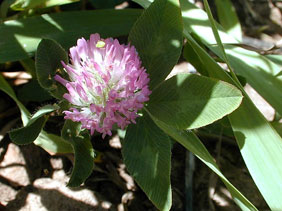RED CLOVER
|
 |
| File Size: 68 KB |
|
|
|
Trifolium pratense L.
|
| Lincoln County, Kansas |
| Biennial or short-lived perennial |
| Height: 6-36 inches |
| Family: Fabaceae - Bean Family |
| Flowering Period: May, June, July, August, September |
|
| Stems: | | Decumbent or erect, several to many, branched, nearly glabrous or hairy. | | Leaves: | | Alternate, long-stalked below, sessile above, palmately 3-foliolate; leaflets egg-shaped or elliptic, .75 to 2.5 long, .5 to 1.5 inch wide, soft-hairy, upper surface with pale V-shaped spot; margins finely toothed or entire; tips sometimes notched. | | Inflorescences: | | Heads, dense, spherical, sessile or short-stalked, 25-80-flowered, terminal. | | Flowers: | | Calyces 5-toothed, glabrous to sparsely hairy; corollas papilionaceous, 1/2 to 3/4 inch long, pink to reddish purple; banner longer than wings and keel; stamens 10, 9 united, 1 free. | | Fruits: | | Pods, egg-shaped; seeds 1-2, small, brownish. | | Habitat: | | Cultivated fields, pastures, waste places, and roadsides, most abundant in heavy, fertile, well-drained soils. | | Distribution: | | Principally east 1/3, scattered occurrence westward in Kansas. | | Origin: | | Red clover was introduced from Europe 200 years ago and now is widespread in the U.S. | | Forage Value: | | Livestock relish it, but over-consumption can cause bloat and diarrhea. | | Uses: | | Produces good quality hay and pasture, and is used in crop rotations and for soil improvement. | | | | See white clover |
|
| Red clover |  | | 78 KB | | Lincoln County, Kansas |
| | Red clover |  | | 80 KB | | Tallgrass Prairie National Preserve, Chase County, Kansas |
| | Red clover |  | | 68 KB | | Tallgrass Prairie National Preserve, Chase County, Kansas |
| | Red clover leaves |  | | 76 KB | | Tallgrass Prairie National Preserve, Chase County, Kansas |
| | Red clover |  | | 94 KB | | Douglas County, Kansas |
|
|
|
|
|
|
|